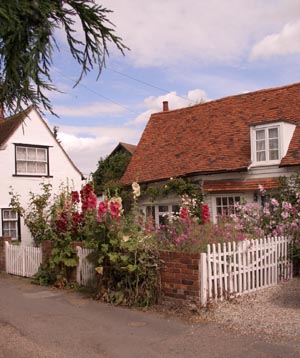In West Mersea we are fortunate to have a number of large green spaces owned, and managed by the Town Council for the benefit of residents and visitors to the Island. These sites are the woodland and grassland at Reymead Meadow and Reymead Wood, the large grassy picnic field at Willoughby car park, the coastal area of St Peter's Meadow and adjoining Monkey Beach, the Glebe Recreation Ground, School Gardens and Youth Field (registered as a Village Green in September 2008, and now together with the "School Field", owned by Mersea Island School, known as West Mersea Park), and Broomhills Greensward.
These "green lungs" are important to the town, especially with the loss of many natural wild areas and the tendency towards smaller gardens. The sites provide a precious relief from the built up environment in which many of us live.
People cherish green open spaces for many reasons, such as peace and quiet, somewhere to walk away from traffic, play games or have picnics. To improve our enjoyment of living in West Mersea, we also try to encourage more kinds of wildlife to our green spaces.
Many local authorities throughout the UK have taken up this challenge - highlighted at the 1992 Rio Earth Summit – to conserve and enhance our local Biological Diversity to create habitats and refuges for once widespread plants and animals.
The Town Council has sought advice on the management of our open spaces from English Nature, Colchester City Council’s Parks department, and the Essex County Council Country Parks department.
West Mersea Town Council try to contribute positively towards the Colchester Biodiversity Action Plan on its Urban habitats.
The Town Council own the beach and water meadow from the Monkey Steps to Hove Creek. It is maintained by our Groundsmen under the guidance of English Nature. The Meadow is a SSSI - A Site of Special Scientific Interest. Our aim is to keep the water meadow true to its past and in keeping with the natural surroundings. The Willow and Aspen trees are pollarded every three years. The Reed Bed is cut back on a three year cycle. The trees along Coast Road, from the bottom of Hove Hill to the Monkey Steps are all protected by Tree Preservation Orders.
In 1965 Dr Alec Grant of the Mersea Island Society registered a 400 yard stretch of the meadow under the Commons Registration Act 1965 as a Village Green. In 1984 a plaque was unveiled to commemorate this event by Mr Len Broadhurst, Mayor of West Mersea.
Mersea has many natural freshwater springs of which St Peter's Well was one. It became the main Public Well and was known for locally for "never having been known to run dry" and reputedly gushed water at the rate of several gallons per minute.
The "Boardwalk" follows a Public Right of Way (No.32) and runs from Coast Road to a shingle-spit beach known as Hove Creek Beach. The boardwalk runs across St Peter's Well Meadow which, as well as being a SSSI, has a European designation as a “Special Conservation Area” (SCA).
West Mersea Town Council is required to maintain the integrity of the site in line with European Habitats Directive. The Boardwalk enhances the SSSI status of the meadow by protecting the saltmarsh. During "spring tides" the Boardwalk is covered by the tide twice a day.


A Cottage in The Lane
The Sensory Garden was created on a piece of land on the corner of Melrose Road/Barfield Road in the year 2000.
This was to be a location where all, but especially the visually impaired, could sit and enjoy the perfume from scented shrubs and flowers. The Council funded the project with donations from local charities. The garden was designed by local landscape gardener, David Morris. The small statue called "Flora" was made by local sculpter Shirley Morrison. The garden is maintained by our Groundsmen.
SITE OF SCIENTIFIC INTEREST (SSSI) AND RAMSAR
Areas of Mersea Island are designated SSSI - Sites of Special Scientific Interest and Ramsar Sites.
WHAT IS A RAMSAR SITE?
The Blackwater Estuary is part of a European highway for migratory birds. A highly protected region covered by several important designations, of which RAMSAR is perhaps the most important.
Ramsar sites are defined as wetlands of international importance designated under the Ramsar Convention (signed in Ramsar, Iran in 1971). Natural England advises on Ramsar sites guided by the criteria set out by the Ramsar Convention, outlined (in brief) below:-
1. Contains rare or unique natural wetlands.
2. Supports vulnerable, endangered species.
3. Supports and provides refuge for plants or animal species at a critical stage in their life cycle.
4. Regularly supports 20,000 or more water birds.
5. Supports significant numbers of indigenous fish species.
6. Is an important source of food for fishes, spawning ground nursery or migratory path on which fish stocks depend.
The small beach adjacent to Dabchicks Sailing Club, Coast Road, is one of several registered village greens in West Mersea. An odd place for a village green but nevertheless it is registered as such. Not so long ago it was used to hang out washing - one of the line posts can still be seen.
Youth Field, West Mersea Park. St. Peter's Well Meadow, and the Parish Church Green.
The Rare Green Winged Orchid - Orchis Morio which can sometimes be seen in May growing around Willoughby car park area.
West Mersea Town Council
10 Melrose Road, West Mersea
Colchester, Essex, CO5 8JD
Email: carol.fountain@westmerseatowncouncil.gov.uk
Telephone: 01206 382128
Office opening hours:
Monday, Tuesday & Friday
9am to 12pm.
You can still contact us by telephone and email at other times.